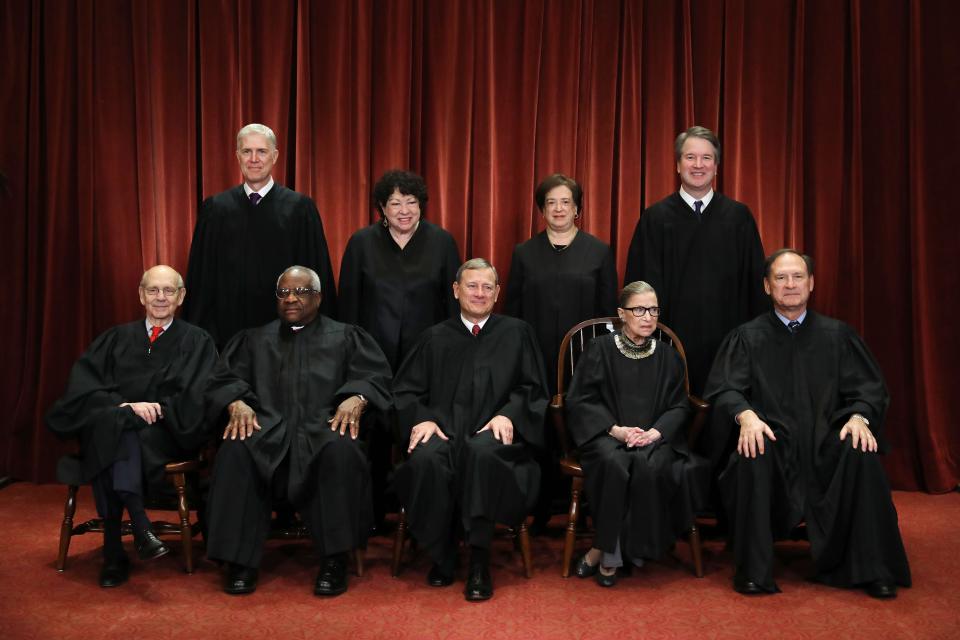What if there's a tie? How the Supreme Court works when there are only 8 justices
WASHINGTON – If the late Ruth Bader Ginsburg's seat on the Supreme Court remains vacant for some time, it won't be anything her colleagues are not accustomed to.
When Associate Justice Antonin Scalia died suddenly in February 2016, Senate Republicans blocked President Barack Obama from filling the seat, which would have given liberals a majority for the first time in decades. The court muddled through with only eight justices for 14 months.
When previous justices died in office or retired before their successors could be confirmed, the court similarly moved forward with eight members, often for months as Senate confirmation hearings dragged on or a nominee was rejected. Most recently, the battle over Brett Kavanaugh's nomination stretched into October 2018, leaving the court shorthanded at the start of its term.
More: Supreme Court Justice Ruth Bader Ginsburg dies, setting up nomination fight
What if there's a 4-4 decision?
The high court also is stuck at eight whenever one justice chooses to recuse from considering a case, often because he or she was involved with it as a judge or lawyer before joining the court. Justices also step aside on occasion because of a financial, family or personal conflict.
Cases that are decided unanimously or by lopsided votes aren't affected. But if the justices are deadlocked, at least initially, it can lead them to find a narrow solution that doesn't advance the law very far in any direction.
If they do emerge 4-4, they can reschedule the case for the following term, hoping for a ninth justice. That happened in July 2020, when Associate Justice Neil Gorsuch cast the deciding vote that put the eastern half of Oklahoma under Native American criminal jurisdiction. A case raising the same issue could not be decided the previous term because of Gorsuch's recusal.
And sometimes, the court simply ties up, rendering its ruling almost meaningless. The tie vote leaves the most recent decision by a lower court intact. There is no new, national precedent created by the nation's highest court.

That happened four times in the months after Scalia's death in 2016, most notably when the court considered President Barack Obama's effort to protect several million undocumented immigrants from deportation. The court deadlocked on the successor to Obama's 2012 DACA policy, leaving intact a federal appeals court decision striking down the expansion.
The court also tied in a major labor rights case threatening public employee unions' long-held right to collect fees from non-members for collective bargaining. That avoided what could have been a major blow to the union movement, but the court in 2018 finally ended the practice.
To the court's credit, it did not devolve very often into even-numbered acrimony after Scalia's death. Instead, Chief Justice John Roberts led the way to a series of minimalist rulings, some of them unanimous.
RBG's memorable opinions: From VMI to Voting Rights Act
Before Scalia, the last justice to die in office was Chief Justice William Rehnquist in September 2005. In that case, the vacancy was extremely brief, because Roberts had already been nominated to replace the retiring Sandra Day O'Connor as an associate justice. Roberts instead was confirmed as chief justice within weeks.
When a justice dies suddenly, any of his or her work left undone must be transferred to a colleague. Even a majority opinion penned by that justice is not official until it has been formally filed.
That was made clear by the Supreme Court in 2019 when it vacated a federal appeals court decision that was filed after the judge who wrote it had died. A California county had asked the high court to reconsider the U.S. Court of Appeals for the 9th Circuit ruling written by Judge Stephen Reinhardt, who died March 29, 2018. The ruling was filed 11 days later, on April 9.
"Federal judges are appointed for life, not for eternity," the justices wrote in an unsigned, five-page opinion.
This article originally appeared on USA TODAY: What if there's a tie on the Supreme Court after Ruth Bader Ginsburg?

